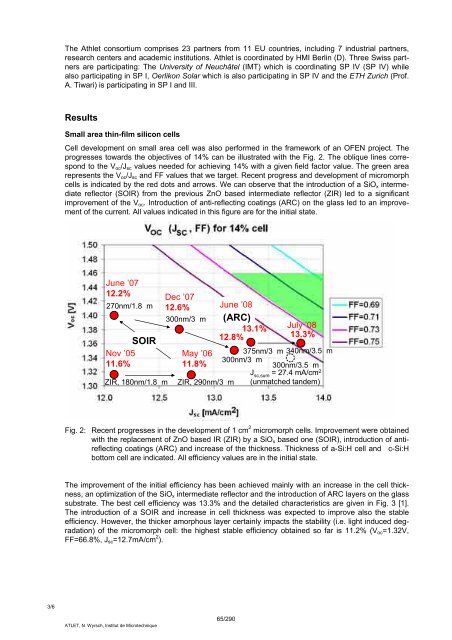Programm Photovoltaik Ausgabe 2009 ... - Bundesamt für Energie BFE
Programm Photovoltaik Ausgabe 2009 ... - Bundesamt für Energie BFE
Programm Photovoltaik Ausgabe 2009 ... - Bundesamt für Energie BFE
Create successful ePaper yourself
Turn your PDF publications into a flip-book with our unique Google optimized e-Paper software.
3/6<br />
The Athlet consortium comprises 23 partners from 11 EU countries, including 7 industrial partners,<br />
research centers and academic institutions. Athlet is coordinated by HMI Berlin (D). Three Swiss partners<br />
are participating: The University of Neuchâtel (IMT) which is coordinating SP IV (SP IV) while<br />
also participating in SP I, Oerlikon Solar which is also participating in SP IV and the ETH Zurich (Prof.<br />
A. Tiwari) is participating in SP I and III.<br />
Results<br />
Small area thin-film silicon cells<br />
Cell development on small area cell was also performed in the framework of an OFEN project. The<br />
progresses towards the objectives of 14% can be illustrated with the Fig. 2. The oblique lines correspond<br />
to the Voc/Jsc values needed for achieving 14% with a given field factor value. The green area<br />
represents the Voc/Jsc and FF values that we target. Recent progress and development of micromorph<br />
cells is indicated by the red dots and arrows. We can observe that the introduction of a SiOx intermediate<br />
reflector (SOIR) from the previous ZnO based intermediate reflector (ZIR) led to a significant<br />
improvement of the Voc. Introduction of anti-reflecting coatings (ARC) on the glass led to an improvement<br />
of the current. All values indicated in this figure are for the initial state.<br />
June ’07<br />
12.2%<br />
270nm/1.8�m<br />
Dec ’07<br />
12.6% June ’08<br />
SOIR<br />
300nm/3�m (ARC)<br />
12.8%<br />
Nov ’05<br />
11.6%<br />
ZIR, 180nm/1.8�m<br />
May ’06 375nm/3�m<br />
300nm/3�m<br />
11.8%<br />
ZIR, 290nm/3�m<br />
13.1%<br />
Jsc,sum = 27.4 mA/cm2 June ’07<br />
12.2%<br />
270nm/1.8�m<br />
Dec ’07<br />
12.6% June ’08<br />
SOIR<br />
300nm/3�m (ARC)<br />
12.8%<br />
July ’08<br />
13.3%<br />
Nov ’05<br />
11.6%<br />
ZIR, 180nm/1.8�m<br />
May ’06 375nm/3�m 340nm/3.5�m<br />
300nm/3�m<br />
11.8%<br />
300nm/3.5�m<br />
ZIR, 290nm/3�m(unmatched<br />
tandem)<br />
13.1%<br />
Jsc,sum = 27.4 mA/cm2 July ’08<br />
13.3%<br />
340nm/3.5�m<br />
300nm/3.5�m<br />
(unmatched tandem)<br />
Fig. 2: Recent progresses in the development of 1 cm 2 micromorph cells. Improvement were obtained<br />
with the replacement of ZnO based IR (ZIR) by a SiOx based one (SOIR), introduction of antireflecting<br />
coatings (ARC) and increase of the thickness. Thickness of a-Si:H cell and �c-Si:H<br />
bottom cell are indicated. All efficiency values are in the initial state.<br />
The improvement of the initial efficiency has been achieved mainly with an increase in the cell thickness,<br />
an optimization of the SiOx intermediate reflector and the introduction of ARC layers on the glass<br />
substrate. The best cell efficiency was 13.3% and the detailed characteristics are given in Fig. 3 [1].<br />
The introduction of a SOIR and increase in cell thickness was expected to improve also the stable<br />
efficiency. However, the thicker amorphous layer certainly impacts the stability (i.e. light induced degradation)<br />
of the micromorph cell: the highest stable efficiency obtained so far is 11.2% (Voc=1.32V,<br />
FF=66.8%, Jsc=12.7mA/cm 2 ).<br />
ATLET, N. Wyrsch, Institut de Microtechnique<br />
65/290







